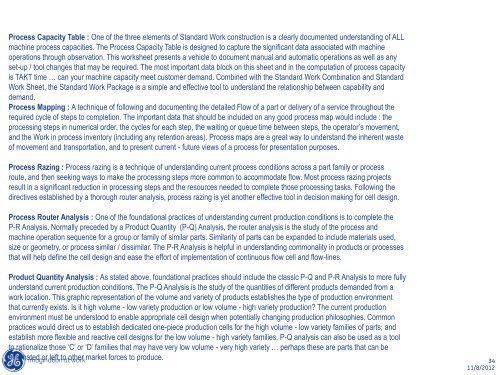Download Presentation - GE Capital
Download Presentation - GE Capital
Download Presentation - GE Capital
You also want an ePaper? Increase the reach of your titles
YUMPU automatically turns print PDFs into web optimized ePapers that Google loves.
Process Capacity Table : One of the three elements of Standard Work construction is a clearly documented understanding of ALL<br />
machine process capacities. The Process Capacity Table is designed to capture the significant data associated with machine<br />
operations through observation. This worksheet presents a vehicle to document manual and automatic operations as well as any<br />
set-up / tool changes that may be required. The most important data block on this sheet and in the computation of process capacity<br />
is TAKT time … can your machine capacity meet customer demand. Combined with the Standard Work Combination and Standard<br />
Work Sheet, the Standard Work Package is a simple and effective tool to understand the relationship between capability and<br />
demand.<br />
Process Mapping : A technique of following and documenting the detailed Flow of a part or delivery of a service throughout the<br />
required cycle of steps to completion. The important data that should be included on any good process map would include : the<br />
processing steps in numerical order, the cycles for each step, the waiting or queue time between steps, the operator’s movement,<br />
and the Work in process inventory (including any retention areas). Process maps are a great way to understand the inherent waste<br />
of movement and transportation, and to present current - future views of a process for presentation purposes.<br />
Process Razing : Process razing is a technique of understanding current process conditions across a part family or process<br />
route, and then seeking ways to make the processing steps more common to accommodate flow. Most process razing projects<br />
result in a significant reduction in processing steps and the resources needed to complete those processing tasks. Following the<br />
directives established by a thorough router analysis, process razing is yet another effective tool in decision making for cell design.<br />
Process Router Analysis : One of the foundational practices of understanding current production conditions is to complete the<br />
P-R Analysis. Normally preceded by a Product Quantity (P-Q) Analysis, the router analysis is the study of the process and<br />
machine operation sequence for a group or family of similar parts. Similarity of parts can be expanded to include materials used,<br />
size or geometry, or process similar / dissimilar. The P-R Analysis is helpful in understanding commonality in products or processes<br />
that will help define the cell design and ease the effort of implementation of continuous flow cell and flow-lines.<br />
Product Quantity Analysis : As stated above, foundational practices should include the classic P-Q and P-R Analysis to more fully<br />
understand current production conditions. The P-Q Analysis is the study of the quantities of different products demanded from a<br />
work location. This graphic representation of the volume and variety of products establishes the type of production environment<br />
that currently exists. Is it high volume - low variety production or low volume - high variety production? The current production<br />
environment must be understood to enable appropriate cell design when potentially changing production philosophies. Common<br />
practices would direct us to establish dedicated one-piece production cells for the high volume - low variety families of parts; and<br />
establish more flexible and reactive cell designs for the low volume - high variety families. P-Q analysis can also be used as a tool<br />
to rationalize those ‘C’ or ‘D’ families that may have very low volume - very high variety … perhaps these are parts that can be<br />
eliminated or left to other market forces to produce.<br />
34<br />
11/8/2012








